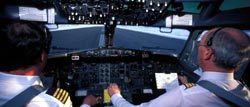Better User Interface Design Could Mitigate “Automation Addiction” and Other Flying Errors, HF/E Experts Suggest

Photo credit: Getty Images / National Geographic Collection
Eric Geiselman and colleagues propose that user interfaces that take advantage of avionics’ underlying data and logic could enable pilots to better cope with extraordinary circumstances like the unavailability of an instrument landing system, as was the case in San Francisco.
In Geiselman et al.’s October Ergonomics in Design article, “Flight Deck Automation: A Call for Context-Aware Logic to Improve Safety,” the authors describe prototype designs that could mitigate errors leading to accidents and incidences such as the A330 Air France Flight 447 crash in 2009 and the airport overfly of Northwest 188 that same year.
A Northwest 188 pilot programmed in an incorrect radio frequency early in the flight, cutting off communication with air traffic control and especially ATC’s alert that the plane had missed the planned descent point by 150 miles. “Through a simple database comparison algorithm,” the authors wrote, “the system can seek clarification when an erroneous frequency is selected . . . and issue an alert.”
In the Air France 447 tragedy, a sensor malfunction caused the autopilot and autothrust to disconnect, which unnecessarily caught the pilots off-guard and began a series of critical errors. Geiselman and colleagues also noted that invisible dual-control inputs, which enable both pilots to enter commands, basically (and by design) canceled out corrective actions attempted by the copilot. The authors developed a prototype concept for visually displaying the actions of both pilots and the aircraft so each pilot can be kept aware of all actions.
The article is intended “to offer a point of departure” for discussion about improvements to cockpit avionics among the design community.
To obtain a copy of the article, contact HFES Communications Director Lois Smith (lois@hfes.org, 310/394-1811).
The Human Factors and Ergonomics Society is the world's largest nonprofit individual-member, multidisciplinary scientific association for human factors/ergonomics professionals, with more than 4,600 members globally. HFES members include psychologists and other scientists, designers, and engineers, all of whom have a common interest in designing systems and equipment to be safe and effective for the people who operate and maintain them. Watch science news stories about other HF/E topics at the HFES Web site.
“Human Factors and Ergonomics: People-Friendly Design Through Science and Engineering”
Plan to attend the 2014 International Symposium on Human Factors and Ergonomics in Health Care: Leading the Way, March 16-19, Sheraton Chicago Hotel and Towers.
Media Contact
More Information:
http://www.hfes.orgAll latest news from the category: Transportation and Logistics
This field deals with all spatial and time-related activities involved in bridging the gap between goods and people, including their restructuring. This begins with the supplier and follows each stage of the operational value chain to product delivery and concludes with product disposal and recycling.
innovations-report provides informative reports and articles on such topics as traffic telematics, toll collection, traffic management systems, route planning, high-speed rail (Transrapid), traffic infrastructures, air safety, transport technologies, transport logistics, production logistics and mobility.
Newest articles

Bringing bio-inspired robots to life
Nebraska researcher Eric Markvicka gets NSF CAREER Award to pursue manufacture of novel materials for soft robotics and stretchable electronics. Engineers are increasingly eager to develop robots that mimic the…

Bella moths use poison to attract mates
Scientists are closer to finding out how. Pyrrolizidine alkaloids are as bitter and toxic as they are hard to pronounce. They’re produced by several different types of plants and are…

AI tool creates ‘synthetic’ images of cells
…for enhanced microscopy analysis. Observing individual cells through microscopes can reveal a range of important cell biological phenomena that frequently play a role in human diseases, but the process of…





















